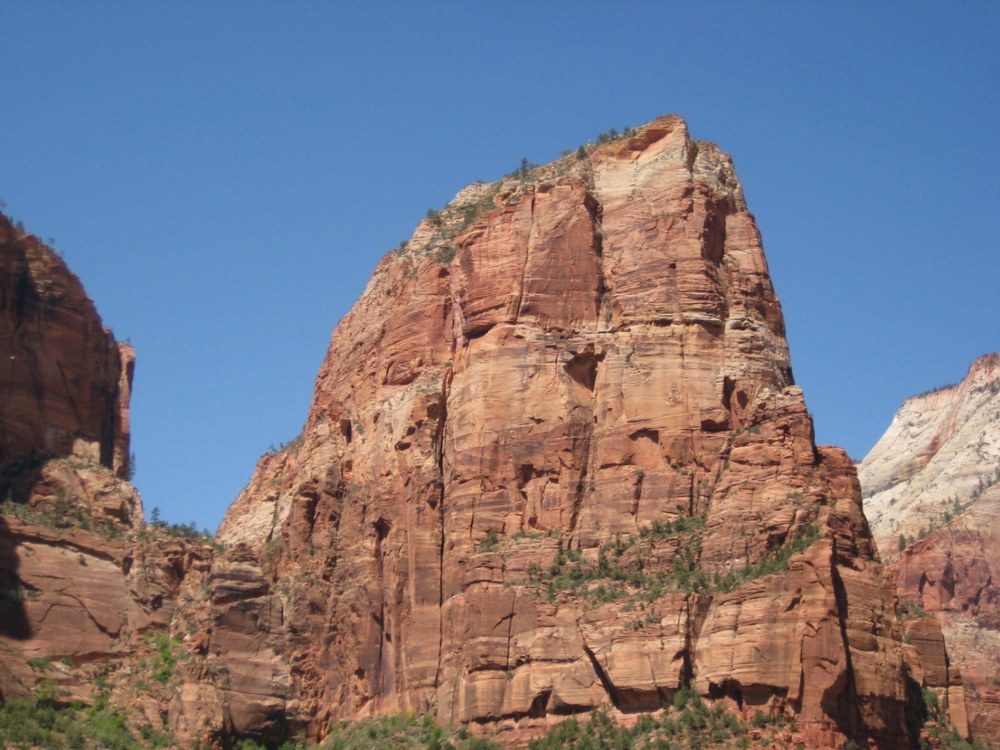
Zion is a national treasure that begs to be explored. It is not only famous for its many hiking trails, including the most dangerous, Angels Landing, but for the milky green Virgin River that shapes what we see today.
Angels Landing is one of the most impressive hikes I’ve ever done. This trail winds uphill, over sand and slick rock, switch backing up the sides of a step rock outcropping to just over 1,500 feet above the Virgin River. In some places peering over the edge leaves your heart thumping, with jaw dropping views of nothing but sheer walls and the river valley below.
To head to Angels Landing, cross the Virgin River directly across the road from the Grotto Picnic area (bathrooms are available here), shuttle bus stop #6, in Zion Canyon. The fairly gentle trail follows the river, on the West Rim Trail, traversing the canyon bottom. This trail is wide and well maintained.
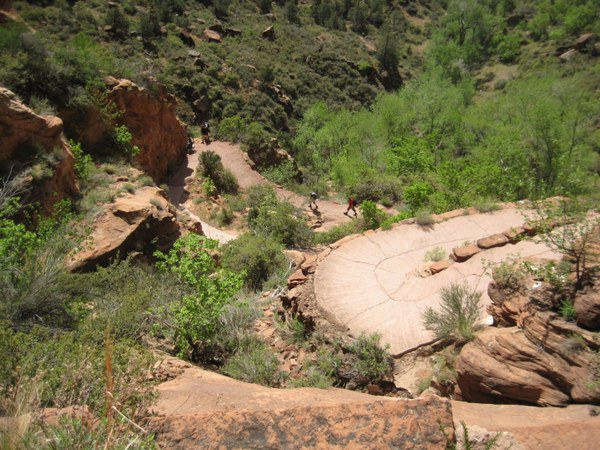 The start of the trail. Photo by Regina Robinson.
The start of the trail. Photo by Regina Robinson.
As the trail switch backs up the canyon wall, a respite from the heat occurs once you reach Refrigerator Canyon. The canyon is shady, cool, and a welcome relief to the soaring temperatures found in Zion during the summer months. From here the switchbacks rise upward again, aptly named Walter’s Wiggles switchbacks. There are 21 short switchbacks that get your heart pumping and thighs burning.
After ascending all 21 switchbacks you come out to an area known as Scout Landing. From here there is only 500ft left to climb. This is a good area to take a break, eat a snack, drink some water, and make adjustments before you start across the Hogsback. Once on the Hogsback you do not want to readjust or try to grab that wayward water bottle. Make sure everything is good to go before heading across. This is no place for selfies; you need your hands to hold onto the chains as you climb.
Standing here on Scout Landing, I was thinking “How bad can this hike really be?” Since 2004, nine people have fallen to their deaths on this route. Safety in the park is your responsibility and begins with proper planning, preparation, and the avoidance of unneeded risks. Casual sneakers and the other poor footwear choices I saw people wearing on this scramble are absolutely not appropriate for this trail. Hiking boots or shoes with good soles are best. This trail at its narrowest is only a foot or so wide, with sheer drops down a 1000ft. Take your time, I did.
 A photo of one of the sheer drops just off the side of the footpath. Photo by Regina Robinson.
A photo of one of the sheer drops just off the side of the footpath. Photo by Regina Robinson.
The last half mile follows the ridge across the saddle, where the last half a mile climbs straight up. Here I saw so many ill-prepared hikers. Most wore chucks, vans, and other tennis shoes that had no grip on the bottom of the shoe. On this slick rock I was scared half to death that one of these unsuspecting individuals would fall trying to catch their jacket they so carelessly carried in their hands. Most thought using the chains for support and guidance was stupid, often forgoing holding on in macho acts of bravado. I wasn’t one of them. I used the chains every chance I got, not trusting my balance as every downward look edged the vertigo ever nearer. I never realized I had a fear of heights until I was on this trail. Deep breathing, focusing on every foot placement and handhold, and a positive, calm attitude, kept me going and able to move past my fears.
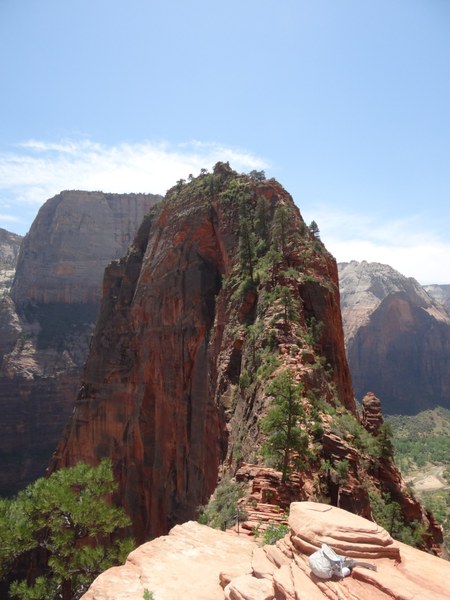 The Hogsback. Photo by Regina Robinson.
The Hogsback. Photo by Regina Robinson.
Getting to the top of Angels Landing is one thing, but getting down is another. Down climbing is dangerous, and that first step downhill is not for the faint of heart.
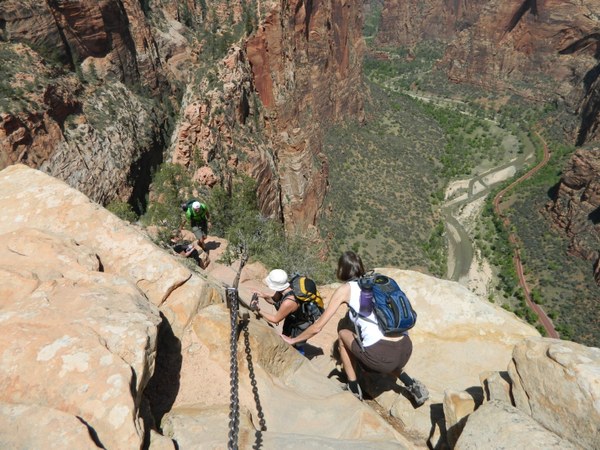 An anxiety-inducing down climb. Photo by Regina Robinson.
An anxiety-inducing down climb. Photo by Regina Robinson.
In some areas of the trail especially down the Hogsback, I found that turning and facing uphill while holding onto the chain, and stepping down and planting a foot firmly, is more reassuring than having my body pitched forward as if I’m going to topple over face first. I also found going down easier when I was helping others over their fear. The steep exposure caused several individuals to start panicking and stop moving. Once that began the lines backed up and nobody could move. At one point there were eight of us moving backwards, slowly, cracking jokes and doing anything but looking downward.
Thankfully this doesn’t last too long and we were once again back on Scout Landing, heading towards Walter’s Wiggles. From here the downhill slog was more like a meander as we contemplated swimming in the cold Virgin River.
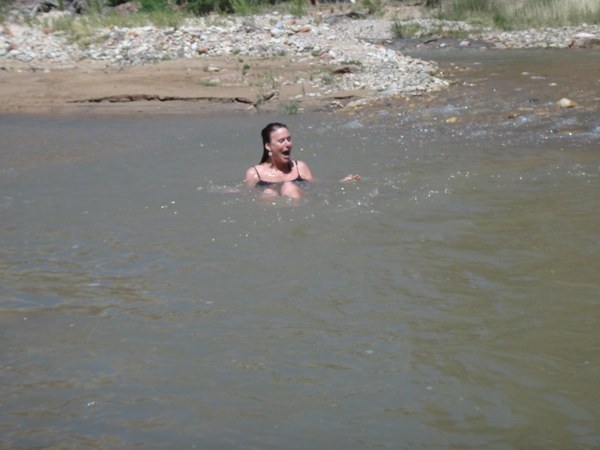 Yes, that water is cold! Photo by T.C. Cromie.
Yes, that water is cold! Photo by T.C. Cromie.
Fees
$35 per vehicle/$30 per motorcycle (this allows access into the park for a week), or show a National Parks and Federal Recreational Lands Pass. If you enter on foot or bicycle it is a $20 fee, children under 15 are free.
- Zion annual pass $70.00
- Interagency pass $80.00
Hike Stats
- Distance: 5.4 miles roundtrip
- Elevation gain: 1488 ft
- High point: 5790 ft
- Difficulty: Strenuous, steep with exposure and long drop offs. This trail is not only physically demanding, but mentally demanding as well; especially if you have vertigo, or a fear of exposure or heights. I would not recommend this trail for those with young children. Attempting this hike in improper foot wear is a bad idea. Angles Landing should not be attempted in high winds, storms, or if snow or ice are present.
Pets
In order to protect wildlife these rules apply:
- Leashed pets are only allowed on the Pa’rus Trail. Pets must be under physical control, and on leash shorter than 6ft, and their pet waste must be removed and disposed of in trash receptacles.
- All other trails, wilderness areas, shuttle busses, and public buildings are off-limits to pets, exceptions apply to service animals only.
- Zion is hot and leaving a pet in a vehicle can often lead to death.
Notes
- Practice LNT principles.
- Parking within the park is often full by 8am, plan on utilizing the shuttle buses especially during peak times in the summer.
- Safety in the park
- Always check current weather conditions, as rain can cause flash floods in the canyon
- Heat conditions vary by day; please carry extra water, snacks, and proper gear for all weather types. Take precautions to avoid heat illnesses while visiting the park.
- Be mindful of the desert environment as it is home to many animals.
- Camping is available at Zion, plan your trip early and make reservations.
- Other activities in Zion besides hiking include: Birding, climbing, canyoneering, cycling, horseback riding, boating, backpacking, and stargazing.
- *This hike took place pre-COVID-19, and the park now has COVID-19 safety measures in place.
packing list
- 10 Essentials
- Sturdy hiking shoes with good soles
- Hiking poles
- Camera
- Extra water and filter. I carried a 3 liter hydration bladder and drank it all, every day; it was refreshing to refill water using my filter at the Virgin River.
- Sun protection including a broad brimmed hat, sunglasses, lip balm, and sunscreen is a must.
- If visiting in winter and early spring, I suggest micro spikes, gaiters, and poles. We needed them, even in April. If hiking the Narrows dry suits are strongly recommended, especially in the fall and early spring.
Main image of Angels Landing from below. Photo by Regina Robinson.
Add a comment
Log in to add comments.Regina this is great; and you are so brave. We visited Zion last September, your photos brought me right back. Thank you.
 Regina Robinson
Regina Robinson